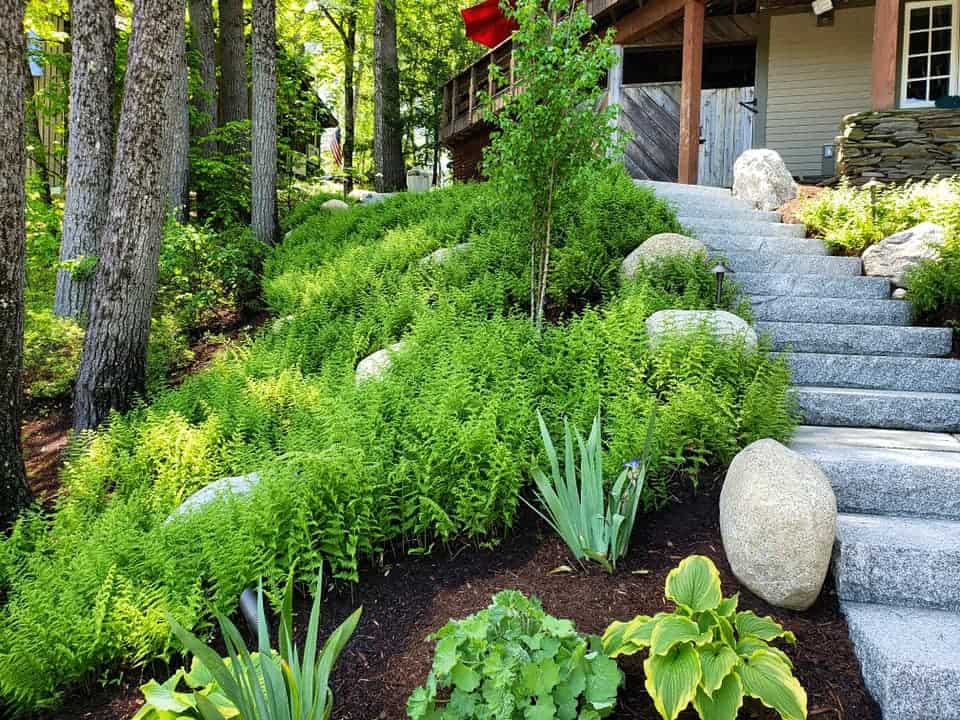
Pictured: Blue Flag Iris, Hay Scented Fern Sod, and Birch.
Native plants occur naturally in this area. They are adapted to our climate and range of soils and also provide food for our native wildlife. They are low-maintenance, require fewer fertilizers and pesticides, and are not considered invasive.
We have chosen these natives for their multi-season beauty and interest, wildlife value and their adaptability to a variety of garden conditions found in the Lakes Region of NH. Other than irrigation in the first year or two, and annual weeding, once established these plants require little else to thrive in our landscapes. Here are our top picks for native plants:
Best shade perennial: Foamflower – Tiarella cordifolia. Foamflower is a beautiful semi-evergreen ground-cover that has pink and white flowers in spring. Fairly deer resistant – not a deer’s first choice – it is perfect for growing in shady areas underneath trees. In rich soil, foamflower can spread annually a few feet in each direction, but it is never invasive. Choose spreading varieties such as ‘Oakleaf’ or ‘Running Tapestry’ if you are looking for a ground-cover effect.
Most fragrant shrub: Sweet Pepperbush – Clethra alnifolia. This medium sized shrub attracts butterflies and grows in forested wetlands, lakeshores or on stream banks in full – part shade or full sun. Although late to leaf out in spring, they have abundant, extremely fragrant, candle-like flower spikes which usually bloom in July-August. Choose Clethra alnifolia ‘Compacta’ for a compact and heavier branched shrub with white flowers or ‘Ruby Spice’ for deep pink flowers. Clethra spreads by rhizomes so give this plant extra space in the garden.
Most adaptable flowering shrub or small tree: Serviceberry – Amelanchier spp. Some species, such as Amelanchier canadensis are native to low woods and swamps, while others such as Amelanchier laevis ‘Spring Flurry’ are adapted to high and dry exposed areas. Serviceberry is a beautiful, multi stemmed, shrub or small tree that grows in full sun or in the understory of larger trees. White flowers cover the tree in April, and they are a bird’s favorite in June as they like to feed on the pink and purple edible berries. The fall foliage can be orange, red and/or yellow, especially when grown in the sun. Two of our favorite Amelanchier’s are ‘Robin Hill’ and ‘Autumn Brilliance.’
Best edible plant: Highbush Blueberry/Lowbush Blueberry – Vaccinium corymbosum/Vaccinium angustifolium. Blueberry is an essential Northern garden plant because of its delicious berries, fiery fall foliage, and depending on the species, ability to grow just about anywhere with some sun. The blueberry is a great plant to place along an eroding shoreline. Our choice for the best Highbush blueberry is ‘Patriot’. It grows 3 – 4′ tall and produces early season fruit. For heavier berry production, plant two different varieties near each other.
Most adaptable large tree: Red Maple – Acer rubrum. Native to swamps, forests, fields, and river and wetland edges. For small spaces choose the improved native ‘Bowhall’ red maple, which is a great shade tree where space is limited. Its maximum height is 40 – 60′ tall and only 10 – 15′ wide, and has a gorgeous yellow to red fall color. ‘Redpointe’ has a great pyramidal form and is a good choice for street plantings.
Best Winter Berries: Winterberry – Ilex verticillata. Known for its heavy crop of red berries in the fall and winter, winterberry is a great plant to add color and interest to the winter landscape. The berries are useful for incorporating into fall and winter planters and arrangements. This medium sized shrub attracts birds and is great for wetland applications since it likes moist, acidic soil. ‘Berry Heavy’ is a prolific female red berry producer which needs a male pollinator, such as ‘Mr. Poppins’ to produce the attractive red berries.
Best Ground Cover: Hay Scented Fern – Dennstaedtia punctilobula. A tough ground cover with a soft, light green texture that does well in sun or full shade. Aggressive, creeps very quickly and is great for locations where you need to cover large areas quickly with something deer resistant, attractive and undemanding. They add fabulous texture to woodlands and landscape plantings.
Best plant for poor soils: Sweet Fern – Comptonia peregrina. Sweet fern is a native shrub with a unique scent. It is a great plant to control erosion and it grows in the poorest, dry soil. If you are interested in attracting birds and butterflies this is a must have plant.
Other great native plants to consider are Blue Flag Iris, Witch Hazel, Red Osier Dogwood, Viburnum, White Birch and Sugar Maples. To learn more about native plants or help in selecting the right plant for the right location stop by Stephens Landscaping Garden Center at 63 Whittier Highway, Moultonborough, NH, and follow us on Facebook and Instagram!

